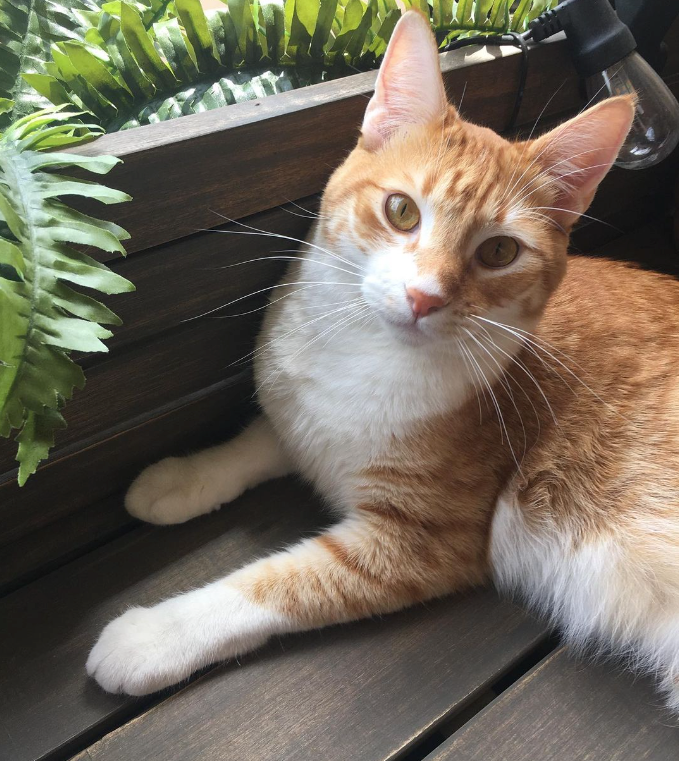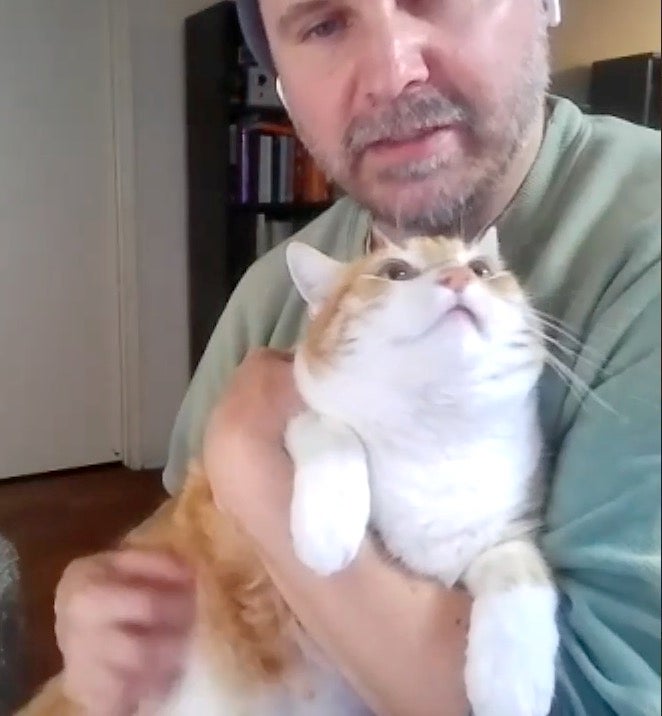
Taters, a 3-year-old orange tabby cat, is having his 15 seconds of fame.
The world met Taters after NASA used a laser to stream a test video of the feline 19 million miles from the Psyche spacecraft to Earth on Dec. 11. The footage, which took 101 seconds to reach the Hale Telescope at the Palomar Observatory in California, was part of a successful test to transmit high-bandwidth data from deep space. You can see the video below.
We wanted to know more about Taters and how the video came about. The following is an edited transcript of a video interview with Joby Harris, a visual strategist at NASA’s Jet Propulsion Laboratory, and proud adopted human of Taters and his sister Dottie.
Q. How did you come up with using a video of Taters for the communications experiment?
Harris: We did some research on the history of communication, whether that would be radio or television, film and just seeing what some of these monumental firsts were. A statue of Felix the Cat was one of the first images tested on television. Plus, in this day and age of the internet, cat videos and cat memes are some of the first as well.
We kept coming back to these videos I was filming of my cat chasing a laser. And it fits the history of early transmission. We looked into stock videos, which were really well-filmed cats chasing lasers, but we kept coming back to my cat, Taters, and his little bit of charm of chasing this laser.
Q. How many cats were in the running to be in the video?
Harris: Five or six, but that was based on stock footage. We looked into cats jumping and diving and, you know, beautiful cats, but it just didn’t have that generic NASA “this is a test” deal. It was almost too good.
What we were kind of going for was as if Taters had gone into NASA and was filmed for movement to test this video. So that’s, I think, why we went back to the innocent and raw charm of Taters.

Q. How did you and Taters meet?
Harris:. It was during COVID, and everyone was in lockdown and working from home. We [at NASA/JPL] braced for a year of working at home, and I wanted to get a kitten. I only planned to get one kitten. As I was holding this one kitten, I felt another one climbing my back, up on my shoulder, and it was Taters. The adopters said yeah, those two are brother and sister and always playing. So, I said okay, well, I’ll take both, and I’m really glad I did. They keep each other company, play, and are best friends. They both had Shakespearean names given to them. So, when I changed it to Taters, I’m not sure if they were too happy with that, but it’s a very fitting name, especially for what’s happening right now.
[Taters’ original name was Orpheus]
Q. How did you come up with the name ‘Taters’?
Harris: I’ve always wanted to name a cat Potato. And when I had Taters as a kitten, he looked like a potato, but then a friend expanded it into, “Oh my gosh, Taters.” And I just was like, “Yes, that’s it”.
Q. How did you film Taters running around with the laser?
Harris: So the early tests were just of him chasing lasers. We didn’t know what we wanted to film. We were using footage of him chasing the laser to work with because we were focused on the data that went over it. But then, we kept returning to Taters’ footage and said we want this, we want him, but it needs to be filmed better. We need a better background.
So, I brought home all this camera and lighting equipment. I even bought a backdrop that was smooth. I set everything up, and I had my laser pointer, and I tried for 45 minutes to get him to chase this laser, and he wouldn’t; just laid there and looked at it. He looked at me like, “Are you kidding me?” I was so mad. I booted him from the room, and I took everything down.
I was on my way to email my team and say we need to get stock footage of a cat or use one of these old ones. As I walked into my living room, he was laying at the center of the couch just looking at me like, “Why so mad bro.” I thought, let me film him here. I sat down, and I filmed with my phone. I pointed the laser, and he went crazy. That’s actually the footage that we used in the video.
I had to work with him on his terms. You know, it’s very telling. He’s all about the couch and not about the lights, the cameras, or anything like that.
Q. According to the data in the video, Taters is on life five out of nine. Why is that?
Harris: I’m not sure. I’m going to trust the data on that. He may have missed the counter a few times when he went to jump up or, you know, probably roughhousing with his sister. Maybe he ate something. I don’t know where those five lives went. But he needs to take care of these next four, that’s for sure. He’s only three years old.
Q. Will Taters make more video appearances?
Harris: I think for NASA, no. You know, that was a test. It traveled 19 million miles with success. He will probably devote himself to talking more about space to anyone who will hear, especially about light movement and lasers. He specializes in light movement analytics. He does have an Instagram where he will occasionally post a lot of the test footage, his auditions, and things like that. People have been doing artwork of him. They’ve really fallen in love with him.
Q. What are some of Taters’ favorite treats?
Harris: His favorite treat, well, he hates salmon. But he loves eating flies. The treats that are cat treats, he’s not interested in. He loves bread. He’s very unusual. But yeah, he won’t eat normal cat things, but he likes crispy and dry for sure.
Q. What is Taters’ favorite place to sleep?
Harris: He has a favorite chair in my room that I purchased to do some reading and some rest. But it’s his perfect fit for his back, so he has taken it over. I have given it to him.
Q. What are his favorite activities?
Harris: He loves to chase little plastic springs. He loves to take them into the bathtub. It’s his arena of play. He loves to play with his sister, Dottie. He has this plastic plant that he loves to rub his face in.
Q. Is the circle cam in NASA’s video also Taters?
Harris: It’s a separate camera looking up at him from another test, one of our previous tests with him. It was very funny. I had multiple camera angles on him as he looked at a laser. And it was like from the bottom up, from the side, from the top down. It was just him, but from all these different angles, just staring at a laser going back and forth. We instantly made everyone laugh. We tried to work that charm back into the test as an Easter egg for people to see at some point. So yeah, that’s called the chin cam.
Q. Does Taters have a favorite planet?
Harris: I think it would be Mars. Just anything with dirt and sand for obvious reasons. I think an entire planet being a litter box would be a dream for him. Cats also love really bad smells. So, he would probably do well on Venus. Or somewhere where there’s just a ton of methane. If there’s dirt and methane, Taters would probably be in heaven.
Q. What is Taters’ mission?
Harris: Taters’ mission has been proving to people that you can do the impossible and never leave your couch.









